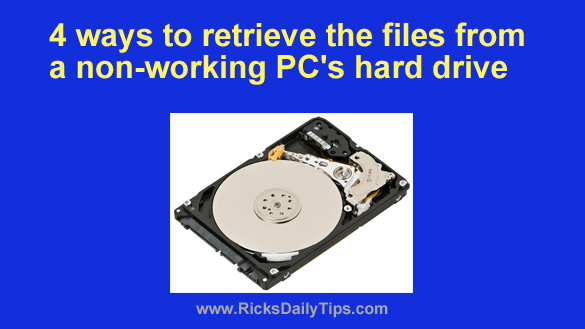 Rick’s Tech Tips Newsletter
Rick’s Tech Tips Newsletter
It seems that every week I receive at least a couple of frantic emails asking me if there’s any way to retrieve the files from a computer’s hard drive after the machine has gone belly-up.
Luckily, many times the answer is YES!
I have covered each of the following methods before, but I thought it might be helpful if I simply list them all in a single post.
First, lets discuss your options if the hard drive is still working (some other hardware issue besides a dead drive caused the system failure)…
1 – Remove the hard drive from the dead PC and install it as a secondary drive in a working desktop computer.
You don’t really even have to mount the drive in a drive bay. I usually just connect the SATA and power cables and let the drive (carefully) dangle from the ends of the cables. Just be sure the drive’s metal housing doesn’t touch anything that it can short-circuit.
The above being said, you can always mount the drive in an open bay and leave it installed as a secondary data drive if you wish.
Whether it has been permanently mounted or not, once the drive has been electrically connected as a second drive you’ll be able to copy the files you wish to save onto another drive using normal Windows file copy techniques.
The advantage of this method is it will cost you exactly nothing except for a little time and effort. There really are no disadvantages that I can think of.
2 – Use a USB to SATA/IDE adapter cable to connect the drive to a working computer’s USB port and then copy the files you wish to retrieve to another drive.
The advantage of this method is you won’t have to open up the working computer’s case in order to connect the drive to the PC. The disadvantage is it will cost you a few bucks to purchase a USB to SATA adapter cable.
3 – Remove the hard drive from the dead PC and convert it into an external USB hard drive.
Once you have installed the drive in an external USB hard drive enclosure you’ll be able to plug it into any open USB port on any working PC and copy the files onto another drive. You can even leave the drive in the enclosure and use it as an external storage or data backup drive if you wish.
As with method 2 above, the advantage of this method is you won’t have to open up the working computer’s case in order to connect the drive to the PC. The disadvantage is it will cost you a few bucks to purchase an external USB hard drive enclosure.
4 – Let me recover the files for you.
That pretty much covers the methods you can use to retrieve the files from a dead computer’s working hard drive. Unfortunately, things get a little more complicated when the hard drive itself is the source of the dead PC’s problem.
If the drive is still active (i.e. you can hear and feel the platters spin up when power is applied), you can connect the drive to a working PC using any of the above connection methods and then use a file recovery utility such as the awesome EaseUS Data Recovery Wizard to attempt to retrieve the files you want or need to salvage.
Note: I use the ‘paid’ version of EaseUS Data Recovery Wizard for my own file recovery jobs, but there are similar tools available that are free.
Just be aware that you’ll need to pay for the upgraded version if you want to use EaseUs Data Recovery Wizard to recover more than 2GB of data.
As long as the platters still spin, it’s often possible to recover individual files even if the file system is so damaged that Windows simply fails to load. It’s always worth a try!
The advantage of this method is it might possibly allow you to prevent having to pay a hefty fee to a data recovery service. The disadvantage is it’s probably the only option you have if you really prefer doing your own file recovery.
And finally, if the drive fails to work at all (no spinning platters and/or silence or strange noises), you’ll likely have to spend some cash for a serious data recovery operation.
Realistically, the only advantage to this method is it might be your only viable option for retrieving your irreplaceable files. The disadvantage is it is quite expensive – typically several hundred dollars.
That pretty much covers all the various options you’ll have if you ever need to recover your files from a dead PC’s hard drive.
Bonus tip: There’s one easy way to make everything I said above a moot point: Be sure to always have a recent backup of the hard drive on hand in case disaster strikes.